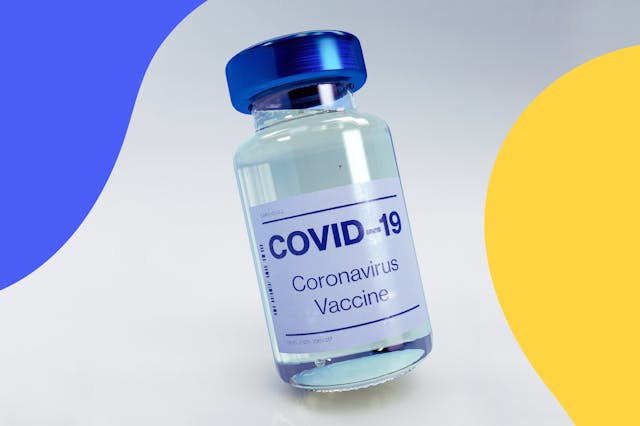
Here's The Latest On The COVID-19 Vaccines

With Covid-19 case rates dropping nationwide, we are nearing a glimpse of a post-Covid future. Still, real hope for a new, new normal is carried by vaccines-- effective, timely, and widespread vaccinations. After a series of unprecedented scientific breakthroughs, five different vaccines have been approved, each with its own mechanism of action, range of efficacy, along with logistical, supply, and cost challenges. Here we survey the leading vaccines approved for distribution.
Pfizer-BioNTech
The Pfizer vaccine, co-developed with the German firm, BioNTech, is a two-shot regimen given three weeks apart. This vaccine takes advantage of mRNA to transport genetic instructions for the Covid-19 spike protein inside human cells. Once the instructions are read by the ribosomes, the cell begins producing copies of the spike protein. These cells are then recognized as intruders and attacked by Helper T cells and B cells. The immune system, now familiar with the spike protein, is prepared to defend against Covid-19 in the wild.
With an efficacy of 95% in preventing infection, Pfizer, along with Moderna, leads the pack. But from a logistical and cost perspective, there are significant challenges. Pfizer’s vaccine requires a “cold chain” of storage that maintains the vials at -94 degrees Fahrenheit. Refrigeration of this grade is not widely available--not at pharmacies or Doctors’ offices--so distribution will likely be slowed. Its cost too, which is twice that of Johnson & Johnson’s, likely places this vaccine out of reach for all but the wealthiest nations. The fact that two doses are required can also be seen as a limitation. The Johnson & Johnson vaccine, in contrast, requires a single dose and can be stored in standard refrigerators.
Moderna
Developed by a Massachusetts biotechnology firm in partnership with the National Institute of Allergy and Infectious Diseases, Moderna’s vaccine also uses mRNA to educate the immune system. A two-dose regimen provides 94% efficacy in preventing Covid infections, and 99% efficacy in preventing severe infections. An important advantage of Moderna’s vaccine is that it can be stored in ordinary refrigerators, making distribution logistics much simpler. But Moderna’s vaccine requires a dose of 100 micrograms (three times that of Pfizer’s) which presents its own supply challenge. Studies are now underway to see if a lower dose would be as effective.
Johnson & Johnson
Johnson & Johnson took a different approach than Moderna or Pfizer. This vaccine does not use mRNA, but rather makes use of a harmless adenovirus which normally causes the common cold. Engineering this virus to carry instructions to make the Covid-19 spike protein enables delivery of the protein’s genetic code to a human cell, where it is then recognized as an intruder and destroyed. This same approach has previously been approved to combat Ebola.
This vaccine is a single-shot regimen with 85% effectiveness against severe Covid infections. In preventing mild to moderate cases, the demonstrated efficacy is 66 percent. Given that this vaccine can be stored in standard refrigeration for months, and that its cost is ⅓ that of Pfizer’s, this may prove the vaccine of choice where logistics and cost are key considerations.
Oxford-AstraZeneca
A partnership between Oxford University and Swiss biotechnology firm, AstraZeneca, has produced a vaccine with 82.4% efficacy in preventing infection. Unlike Pfizer and Moderna, the Oxford team decided to use double-stranded DNA rather than mRNA to transport spike protein genes. Due to DNA’s robust protein coating which makes it much sturdier than mRNA, this vaccine needn’t be frozen and has a long shelf-life in ordinary refrigeration.
Using a well-studied and previously approved technique pioneered by Johnson & Johnson in its Ebola vaccine, the Oxford team uses a modified chimpanzee adenovirus to transport spike protein building instructions into human cells, thus provoking an immune response. The modified adenovirus is safe to use in this scenario as it can enter cells, but cannot replicate inside them.
While its safety and efficacy for those over 65 and for children is still to be determined, for the broad middle demographics, this vaccine’s low cost (3-4$/dose) and logistical simplicity makes it an appealing option for many nations.
Novavax
A Maryland-based firm utilized a well-known technique for modifying a gene and then allowing it to infect a host cell in order to harvest modified but inert infectious agents. Here, a modified version of the Covid spike protein was allowed to infect a moth cell which then produced altered spike proteins. They then harvested those spike proteins and assembled them into nanoparticles, which mimic the structure and function of real-world spike proteins, but have no power to infect or cause illness.
These nanoparticles then in circulation, the immune system is encouraged by a chemical attractant to see and destroy the nanoparticles. But while the particles are not infectious, the immune system has learned to identify and destroy the Covid-19 spike protein.
Like the Oxford-AstraZeneca and Johnson & Johnson vaccines, the Novavax vaccine does not need to be frozen and has a 3-month shelf life under ordinary refrigeration. With an efficacy rate of 89% and simple logistics, Novovax could become a critical asset in the fight against Covid.
Concerns about the new COVID-19 variants
Scientists think the Moderna and BioNTech vaccines will still work against two variants of concern that were first identified in the United Kingdom and South Africa, but emerging evidence — including from a different experimental vaccine trial — suggests that the protection might be considerably less complete.
Novavax — which, by the way, is in the midst of a large late-stage trial in North America — proved effective at stopping symptomatic infections in global hot spots where concerning variants are dominant, the company announced Thursday. However, warning signs lurked amid those findings: The protective effect of the vaccine was substantially muted in South Africa, where a worrisome virus variant is in wide circulation.
Dr. Fauci said that the more crucial measure was the ability to prevent severe disease, which translates to keeping people out of the hospital and preventing deaths. And that result, for Johnson & Johnson, was 85 percent in all of the countries where it was tested, including South Africa, where a rapidly spreading variant of the virus had shown some ability to elude vaccines.



